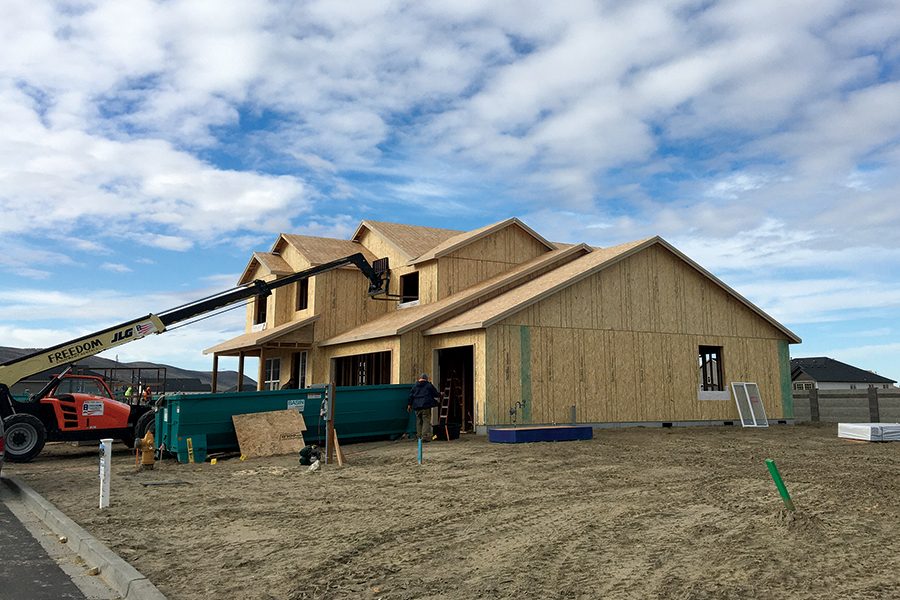
Home » Job growth continues to fuel housing demand
Job growth continues to fuel housing demand

January 13, 2022
The upside-down economics of the pandemic are driving the Tri-Cities into something of a quandary.
Record job development coupled with a severely constrained supply of homes for sale means it will continue to be difficult to buy a home. But it isn’t impossible, and the situation isn’t a crisis, according to industry leaders.
"A crisis? No,” said Ron Almberg, managing broker for Keller Williams Realty of Tri-Cities and the 2022 president of the Tri-City Association of Realtors.
That does not mean everything is rosy, though. Rising prices will continue to dog first-time home buyers as fewer and fewer homes sell for $350,000 or less.
Almberg said new development could ease the supply crunch. Rising wages will make it easier for buyers to meet new prices, which hit an average of $425,000 in November, the most recent available.
“I really am optimistic” he said. “We have a really great homebuilders association here. There is a lot of work and effort to get homes on the market.”
He’s looking to Olympia as well to boost development. Gov. Jay Inslee’s housing package includes efforts to loosen zoning laws to promote “middle housing” by allowing denser development, including auxiliary dwelling units.
“I am optimistic,” he reiterated. “I don’t think the wheels are going to fall off the cart.”
A crisis isn’t afoot, but the housing and job trends clearly add up to a strain on housing.
Year-end housing starts weren’t available, but new home starts were running even with 2020 and 2019 in November, with a total of 1,526 homes authorized by local building agencies.
Richland led with 387 permits, followed by Pasco with 346, West Richland with 232 and Kennewick with 200. (Kennewick permit data is lagging due to a conversion to a new computer system, so the year end tally could jump significantly.)
Contrast that with a robust year for economic development.
In 2021, new and existing employers announced plans to add thousands of new jobs at warehouses and food processing plants, chiefly in Pasco.
Amazon Inc. intends to employ 1,500 at its two new warehouses, now under construction near Sacajawea State Park.
Darigold Inc. is expected to induce an equal number of new jobs when it opens its state-of-the-art milk and butter plant north of Pasco. Reser’s Fine Foods is expected to add several hundred local employees when its new plant opens east of the Tri-Cities Airport.
The Tri-Cities already had a robust workforce before Amazon, Reser’s and the others selected it for new development.
There were nearly 142,000 jobs in the market in October, according to the most recent employment figures from the Washington Employment Security Department. That’s about 500 more than October 2019, before pandemic-related layoffs upended the economy.
The for-rent market, chiefly apartments, was operating with low vacancy rates, and the for-sale market was already operating on slim inventories, with about 400 homes for sale at any given point. That’s well below the optimal 1,200 to 1,500 a market of 300,000-plus people normally sees.
Businesses are watching, said Karl Dye, president of Tri-Cities Development Council, or TRIDEC.
“The factor of attracting those people here or keeping people here, it all relates to, how much does it cost to live here? And housing is a huge part of that,” he said.
Home prices rose about 30% between November 2019 and the same month in 2021, when the average home sold for $425,000, according to the Realtors association. Supply chain challenges are having an impact too.
In early January, the National Association of Home Builders said a spike in lumber prices has added another $18,600 to the cost of a new home. As of Dec. 29, it said framing lumber was up 167% from August.
To afford a $425,000 home, a buyer would need $85,000, or 20% for the down payment and an annual income of about $63,000, to afford a standard mortgage covering the rest. The median household income in the Tri-Cities is about $71,000.
For some new developments, $425,000 is not that much more than the starting price. A new three-bedroom, two-bathroom home with 1,550 square feet in The Heights at Red Mountain Ranch in West Richland had an asking price of more than $394,000 in early January.
That speaks to a related symptom of a challenging market: For nearly two years, new homes have accounted for 60% of home sales, according to Almberg. That’s two to three times higher than normal, when resales dominated the market.
Dye said the region’s vaunted affordability has long been a selling point. It is a growing topic of conversation and one of the top two issues for businesses looking to expand or locate in the Tri-Cities.
“Affordability is really a challenge,” he said.
It started discussing the subject last year and is eager to cast the issue in terms of workforce housing.
The good news is the Tri-Cities isn’t alone.
“This issue is one that other parts of our state have faced for a lot longer than we have,” he said.
Dave Retter, president of Retter and Co. Sotheby’s International Realty, one of the region’s largest residential real estate firms, agrees with Almberg that the market isn’t in crisis. But it does need more affordable options for first-time buyers.
In December 2020, 73 homes priced at $250,000 and below sold. In 2021, that was down to 39. In 2020, 16.5% of homes sold for $250,000 or lower. That dropped to 10.3% in 2021.
“We’re seeing prices going up,” he said, noting that more upmarket homes – $750,000 and above – are closing.
“What that tells me is our economy here is very, very strong with dual income families where they are able to afford the house that they want,” he said.
“We have to figure out how to get entry-level homes going in the Tri-Cities.”
Real Estate & Construction Local News
KEYWORDS january 2022




